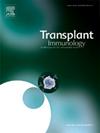Serum PD-L1 and CTLA-4 levels as biomarkers of acute rejection and renal dysfunction in kidney transplant recipients
IF 1.4
4区 医学
Q4 IMMUNOLOGY
引用次数: 0
Abstract
Purpose
Acute rejection in kidney transplantation is a critical barrier to long-term graft survival and the PD-1/PD-L1 and CTLA-4 molecules are crucial for the tolerance of alloreactive T cells against tubular epithelial cells. Our study aims to assess the role of these soluble PD-L1 and CTLA-4 molecules as biomarkers for non-invasive immunosurveillance after renal transplantation.
Methods
Blood samples from 65 recipients were investigated for serum sPD-L1 and sCTLA-4 molecules at the time of kidney transplantation (baseline), in 3 time-points (15, 60 and 365 days) post-transplant, and when acute rejection (ACR) was suspected. Samples and standards were processed in duplicate using sandwich ELISA.
Results
We revealed dynamic changes in serum expression over time, with a significant decrease from the time of kidney transplantation to the various monitoring points, except at the time of acute rejection when the levels increased. Multivariable logistic regression revealed that the sPD-L1 15-day post-transplant is an independent variable for ACR onset (AOR = 1.196 p = 0.020), and with a moderate discriminatory power (AUC = 0.717, p = 0.031), together with PD-L1 60 days, for the occurrence of rejection within 1 year from transplant. sPD-L1 after 15 days shows a predictive role also for DGF (AUC = 0.738, p = 0.001) and graft dysfunction at 60 days (AUC = 0.672, p = 0.022). Furthermore, a higher 15-day expression of sCTLA-4 in patients with ACR compared with those with stable graft (114.8 pg/mL vs. 67.8 pg/mL, p = 0.018) was reported.
Conclusion
These analyses suggest the potential role of these serum molecules as dynamic biomarkers of inflammation and immunoregulation in AKI and acute rejection; they may indicate new immunotherapy targets, useful for modulating tolerance and assist the clinician in identifying patients at risk of rejection or kidney failure.
血清PD-L1和CTLA-4水平作为肾移植受者急性排斥反应和肾功能障碍的生物标志物
目的肾移植急性排斥反应是移植物长期存活的关键障碍,PD-1/PD-L1和CTLA-4分子对同种异体反应性T细胞对小管上皮细胞的耐受性至关重要。我们的研究旨在评估这些可溶性PD-L1和CTLA-4分子作为肾移植后非侵入性免疫监测的生物标志物的作用。方法对65例肾移植受者在肾移植时(基线)、移植后3个时间点(15、60和365天)和怀疑急性排斥反应(ACR)时的血清sPD-L1和sCTLA-4分子进行检测。样品和标准品采用夹心ELISA法一式处理。结果我们发现血清表达随时间的动态变化,从肾移植时间到各监测点,除急性排斥反应时间外,血清表达水平明显下降。多变量logistic回归显示,移植后15天sPD-L1水平是ACR发生的自变量(AOR = 1.196 p = 0.020),与移植后60天PD-L1水平一起具有中等判别力(AUC = 0.717, p = 0.031),是移植后1年内发生排斥反应的自变量。15天后sPD-L1对DGF (AUC = 0.738, p = 0.001)和60天后移植物功能障碍(AUC = 0.672, p = 0.022)也有预测作用。此外,与移植稳定的ACR患者相比,ACR患者15天内sCTLA-4的表达更高(114.8 pg/mL vs 67.8 pg/mL, p = 0.018)。结论这些血清分子可能在AKI和急性排斥反应中作为炎症和免疫调节的动态生物标志物;它们可能提示新的免疫治疗靶点,有助于调节耐受性,并帮助临床医生识别有排斥或肾衰竭风险的患者。
本文章由计算机程序翻译,如有差异,请以英文原文为准。
求助全文
约1分钟内获得全文
求助全文
来源期刊

Transplant immunology
医学-免疫学
CiteScore
2.10
自引率
13.30%
发文量
198
审稿时长
48 days
期刊介绍:
Transplant Immunology will publish up-to-date information on all aspects of the broad field it encompasses. The journal will be directed at (basic) scientists, tissue typers, transplant physicians and surgeons, and research and data on all immunological aspects of organ-, tissue- and (haematopoietic) stem cell transplantation are of potential interest to the readers of Transplant Immunology. Original papers, Review articles and Hypotheses will be considered for publication and submitted manuscripts will be rapidly peer-reviewed and published. They will be judged on the basis of scientific merit, originality, timeliness and quality.
 求助内容:
求助内容: 应助结果提醒方式:
应助结果提醒方式:


